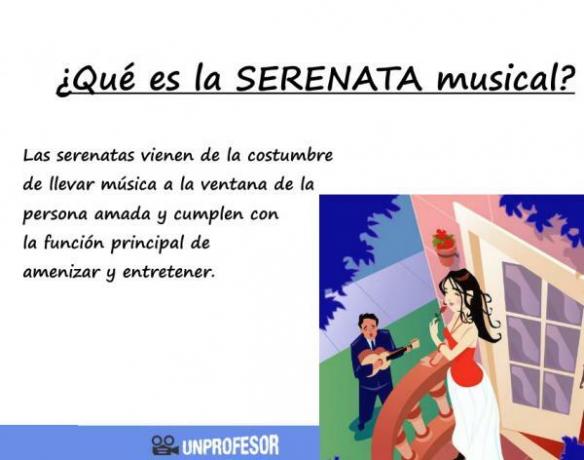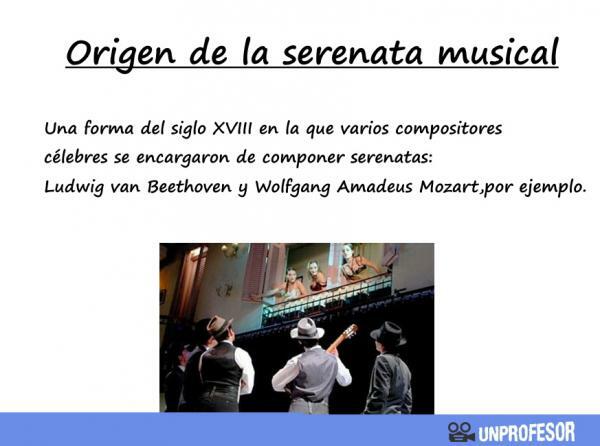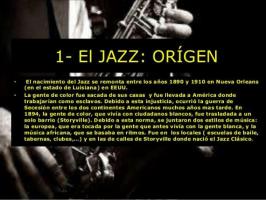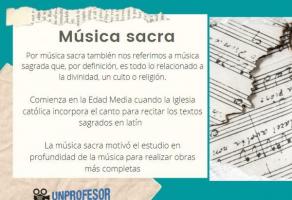What is a musical SERENATA

Fun, evening, night... are some words that you may have related when hearing the word "serenade" but have you ever wondered where this word really comes from and what does it mean in the field of music? In this lesson from a TEACHER we will talk about what is a musical serenade and what are the characteristics of this form that dates back in popularity to the eighteenth century.
Index
- What is the serenade in music
- Origin of the serenade and its legacy
- Characteristics of the serenade
- Most popular serenade composers
What is the serenade in music.
The serenade is a musical form, that is to say, a type of music that we recognize by certain specific characteristics. During the eighteenth century This musical form became very popular as a “diversion”, a way to please and entertain guests who came to the hosts' homes as a social event.
Since the serenade fulfilled the main function of entertainingThe works in this way are calm and not very bizarre, hence its name derived from "serene" which means calm or rested.
Origin of the serenade and its legacy.
The serenades come from the custom of bring music to the window of the loved one in the afternoon or evening, usually as a form of apology for a previous dispute. It is from here that the serenade is related to relationships, the night and love, to the point that in several countries of Latin America this is maintained in a certain way popular way custom which consists of bringing a musical ensemble at night to the home of a person of romantic interest, to perform live music. Usually in these cases traditional music groups are used, such as the mariachi (grouping of strings and brass winds in Mexico) or The tuna. These interpretations express messages of gratitude, love or reconciliation.
Returning to the classical field of music, it is known that the term was used since the music of the Baroque period, relating to the cantatas and the opera. Now, in more formal terms, it is recognized as a form of the 18th century in which several famous composers were commissioned to compose serenades. Ludwig van Beethoven (Op. 25 for flute, violin and viola / Op. 8 for string trio) and Wolfgang Amadeus Mozart for For example, who composed 13 serenades that were usually used in social celebrations such as weddings or parties courtesans.
Although in these times serenades were written for small ensembles of instruments, in the 19th century, serenades were used for larger formations such as orchestras, this was the case for composers such as Johannes Brahms and Antonin Dvorak. They can also be related to the song or lied, as is the case with Franz Schubert or Richard Straus and, finally, to be played specifically on the piano, with the example of the Impressionist composers Claude Debussy and Maurice Ravel.

Characteristics of the serenade.
By nature of the concept and as far as classical music is concerned, the serenade is of moderate tempo, elegante and feeling calm or bright. The instrumentation therefore requires pleasant harmonies, consonants, balanced structures and without much contrast or sudden dynamism.
In terms of training, the serenade varies a lot due to the fact that it could even be performed by an instrument soloist with his own voice, if we speak colloquially. In a popular sense as we mentioned earlier, it can be written for string ensembles or typical instruments. Finally, as far as the classical context is concerned, the serenade was written for chamber ensemble, orchestra with a predominance of stringed instruments and winds, soloist piano and piano as an accompanying instrument for the voice.
As to structure, its shape varies widely as well. In the case of the 18th century, the serenade could even consist of up to 10 movements. In Mozart's serenades, for example, they began with a march, followed by slow movements that alternate with minuets, followed by a rondo, and the ending is bright in tone, sometimes a march of new.
Most popular serenade composers.
- Baroque Period: Alessandro Stradella, Alessandro Scarlatti, Johann Joseph Eux, Johann Mattheson, Antonio Caldara, among others.
- Classic and romantic period: Wolfgang Amadeus Mozart, Ludwig van Beethoven, Johannes Brahms, Hector Berlioz, Franz Schubert, Richard Strauss, Antonin Dvorak, Piotr Tchaikovsky, Edward Elgar, Jean Sibelious, among others.
- Twentieth century: Benjamin Britten, Igor Stravinsky, Arnold Schönberg, Dimitri Shostakovich and Leonard Bernstein, among others.
Most outstanding works
- Serenade No.13 “Eine Kleine Nachtmusik” - Wolfgang Amadeus Mozart
- Serenade for Strings Op.8 - Ludwig Van Beethoven
- The Ständchen D.957 - Franz Schubert
- Serenade No.1 in D major Op.11 - Johannes Brahms
- Sérénade Grotesque for piano (1893) - Maurice Ravel
- Serenade based on Plato's Banquet - Leonard Bernstein
Now that you know what a musical serenade is, thanks to this article by a PROFESSOR, it would be interesting for you to find a moment to dedicate yourself to listening to some works in this way to better understand the knowledge you have learned.
If you want to read more articles similar to What is a musical serenade, we recommend that you enter our category of Music history.



